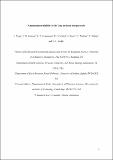Ammonium availability in the Late Archaean nitrogen cycle
Abstract
The bioavailability of essential nutrients such as nitrogen and phosphorus has fluctuated with the chemical evolution of Earth surface environments over geological timescales. However, significant uncertainty remains over the evolution of Earth’s early nitrogen cycle, particularly how and when it responded to the evolution of oxygenic photosynthesis. Here we apply multi-proxy geochemical analyses (Fe speciation, δ13C and δ15N) to exceptionally well-preserved shales from the approximately 2.7 billion year old Manjeri Formation in the Belingwe Greenstone Belt, Zimbabwe, to evaluate the redox status of Earth’s early nitrogen cycle and decipher feedbacks associated with the initial stages of planetary oxygenation. These continental shelf sediments were previously linked to early cyanobacterial oxygen production, and provide a direct test of conflicting hypotheses concerning the importance of nitrogen oxyanions in the Late Archaean era. Our data reveal a dominantly anaerobic marine nitrogen cycle in which ammonium-replete ferruginous waters underlay an ephemeral oxygen oasis. Driven by the emergence of oxygenic photosynthesis, increased primary productivity could have periodically strengthened export production, which allowed for the accumulation of ammonium in the water column during organic matter degradation. Restricted oxygen availability could have allowed the upwelling ammonium to reach the photic zone to provide ample nitrogen to fuel a prolific Late Archaean biosphere.
Citation
Yang , J , Junium , C , Grassineau , N , Nisbet , E , Izon , G J , Mettam , C W , Martin , A & Zerkle , A L 2019 , ' Ammonium availability in the Late Archaean nitrogen cycle ' , Nature Geoscience , vol. 12 , no. 7 , pp. 553-557 . https://doi.org/10.1038/s41561-019-0371-1
Publication
Nature Geoscience
Status
Peer reviewed
ISSN
1752-0894Type
Journal article
Description
This study was supported financially by Natural Environment Research Council Standard Grants NE/M001156/1 (to ALZ, EN, and NG) and NE/J023485/2 (to ALZ), and National Science Foundation NSF EAR-1455258 (to CKJ). GI acknowledges continued support from the Simons Foundation (SCOL:290361).Collections
Items in the St Andrews Research Repository are protected by copyright, with all rights reserved, unless otherwise indicated.

